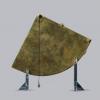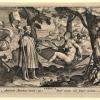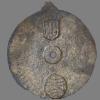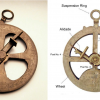Mariner’s astrolabe, Spain, bronze (c. 1600)
Commentary
Mariner’s astrolabes were used to measure the height of the Sun and stars, allowing their users to calculate their position at sea. The word ‘astrolabe’ comes from the Greek word astrolabos, meaning ‘star-taker’. However, the mariner’s version has none of the mathematical and astronomical features of other astrolabes. It instead has several holes allowing wind to pass through, making it easier to be held steadily at sea.
Mariner’s astrolabes were used by Portuguese and Spanish explorers during the fifteenth and sixteenth centuries. During this time, sailors were unable to calculate longitude, so latitude-measuring navigational instruments were very important. This specific instrument was found during dredging works in 1903 in the Veracruz harbor in the Gulf of Mexico. Veracruz was a key port in the New Spanish Empire, receiving many Spanish ships navigated by the mariner’s astrolabe. This specific model is one of only around 100 known to exist.
On Loan from the History of Science Museum, University of Oxford, Inv. 54253
To learn more about the mariner's astrolabe, see the clip below.




